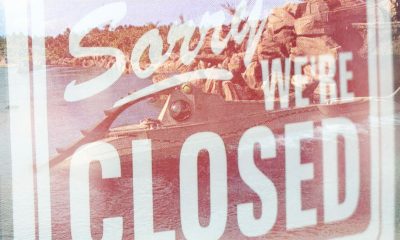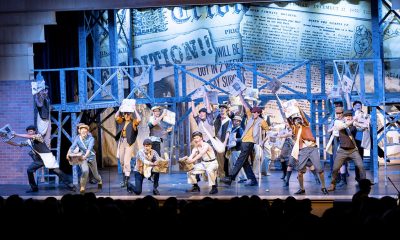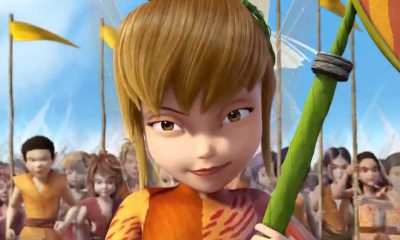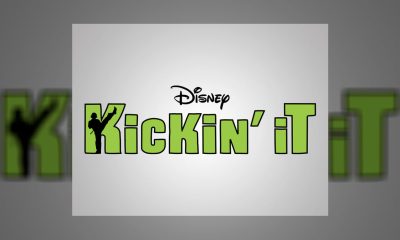History
Why For were Tweedle Dum & Tweedle Dee banned from the Disney theme parks?
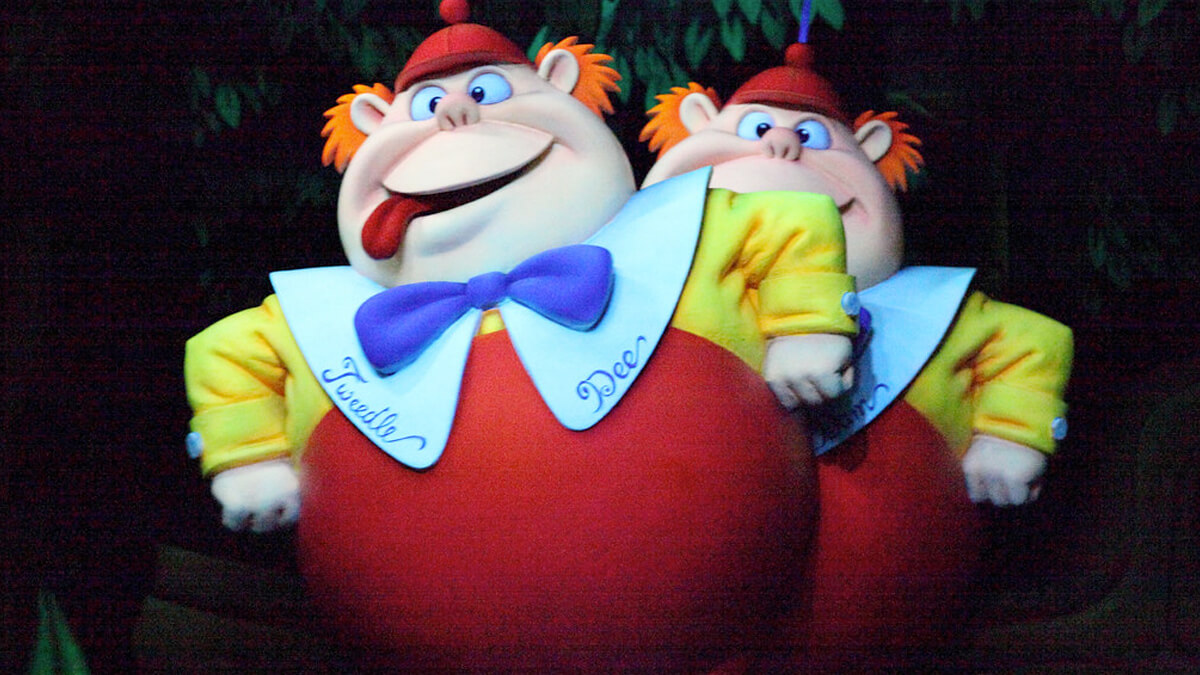
Jeannine B. writes in to say:
I have a friend who worked in the Character Department at the Magic Kingdom back in the 1980s. She has lots of great stories about what it was like to be a member of the Zoo Crew back then. But one of the stranger ones that my friend tells is about when Michael Eisner wouldn’t allow the walk-around versions of Tweedle Dum & Tweedle Dee to appear in the theme parks for a few years. Did that really happen? And if so, do you know the story behind that story?
Dear Jeannine B.
Yep. Your friend is right. For about a 5 year-long period there (which ran roughly from 1986 to 1991), though the Company never cut Tweedle Dum & Tweedle Dee’s scene out of Alice Disney’s 1951 animated feature …
 Copyright Disney Enterprises, Inc. All rights reserved
Copyright Disney Enterprises, Inc. All rights reserved
… and the Brothers Dee & Dum remained on display inside of Disneyland‘s “Alice in Wonderland” dark ride …
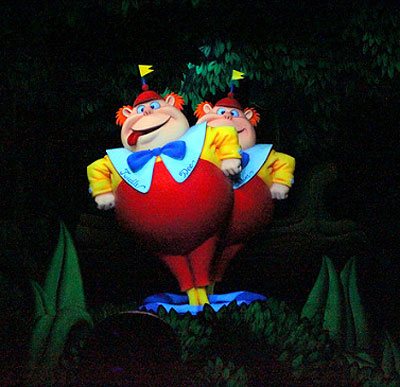 Copyright Disney Enterprises, Inc. All rights reserved
Copyright Disney Enterprises, Inc. All rights reserved
… the walk-around versions of the Tweedles really were barred from appearing inside of the Disney theme parks. And it was Michael Eisner himself who was allegedly inadvertently responsible for this ban.
Why For? Well, the way I’ve always heard this story is that it dates back to February of 1986. Which was when ABC began running “The Disney Sunday Movie.”
 Copyright Disney Enterprises, Inc. All right reserved
Copyright Disney Enterprises, Inc. All right reserved
The then-CEO of The Walt Disney Company was shooting an intro for “Alice in Wonderland” (which then aired an episode of this weekly anthology series). And while Eisner was on set with all of the Alice walk-around characters shooting this particular introduction for that ABC program, he reportedly remarked that Tweedle Dum & Dee’s rounded facial features made them look a lot like mongoloids. Michael then supposedly wondered aloud whether it was wise to allow characters which looked like this to continue to appear inside of the theme parks.
Just for a moment or so there, Eisner allegedly seemed genuinely concerned that if parents with retarded children encountered Tweedle Dum or Tweedle Dee while they were visiting Disneyland or Walt Disney World, they’d then think that Disney was making fun of their kids. Then Michael turned his attention back to shooting this “Alice in Wonderland” -themed intro for “The Disney Sunday Night Movie. ” And – once that was done – Eisner exited the set and then went back to work.
 Michael Eisner in front of the old Feature Animation building, shooting an intro for “The Disney Sunday Night Movie” in 1986. Copyright Disney Enterprises, Inc. All rights reserved
Michael Eisner in front of the old Feature Animation building, shooting an intro for “The Disney Sunday Night Movie” in 1986. Copyright Disney Enterprises, Inc. All rights reserved
And that should have been the end of it. Except that one of Michael’s flunkies was on set while he was shooting the “Alice in Wonderland” intro. And having heard what his boss said, this earnest young assistant then went back to their office and typed up a memo. Which he then sent off to Dick Nunis, the president of Walt Disney Parks and Resorts.
“And what did this memo say?,” you ask. Just what Michael Eisner had said off-the-cuff on set. That The Walt Disney Company’s then-relatively new CEO suddenly had concerns about Tweedle Dum & Tweedle Dee. And rather than potentially upset the parents of developmentally-disabled children, Eisner’s office was now insisting that the walk-around versions of these “Alice in Wonderland” characters be pulled from the parks.
Mind you, what was kind of ironic about all this was – just as this memo was being sent off to Dick Nunis’ office – a public service announcement that prominently featured the walk-around versions of Tweedle Dum & Tweedle Dee had begun airing nationally. Which had the Brothers Tweedle showing school children the safest way to cross the street.
Anyway … Nunis now issues a memo of his, echoing what the message from Eisner’s office had said. Only Dick’s version said that – due to Guests complaints – Tweedle Dum & Tweedle Dee were no longer allowed to appear publicly in the Disney theme parks.
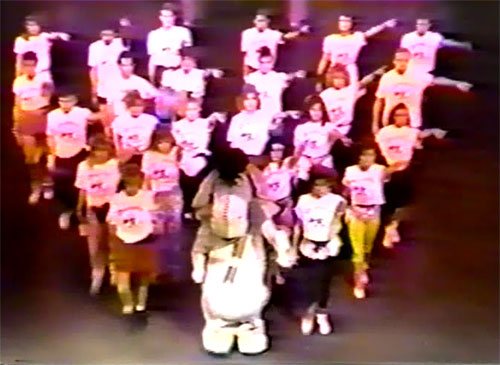 Copyright Disney Enterprises, Inc. All rights reserved
Copyright Disney Enterprises, Inc. All rights reserved
As you might imagine, the Cast Members who worked in the Character Department (many of whom genuinely enjoyed getting dressed up and then going out in the Parks to perform as the Tweedles) thought that this was the silliest decision that Walt Disney Parks & Resorts management had ever handed down. Which is why these Cast members then decided to make fun of it every chance that they got.
Take – for example – “Captain Eeyore.” Which was this beat-for-beat remake of Michael Jackson’s 3D movie that Disneyland’s Zoo Crew shot in that theme park after-hours, so that this Cast-Member-made video could then be used as entertainment at the Character Department’s annual banquet. Only in this Disney-themed parody, the King of Pop‘s part was played by Winnie the Pooh’s rather gloomy friend. And as for Angelia Huston‘s spider-like Supreme Leader, she was reimagined as this kind of Insane Clown Posse version of Minnie Mouse.
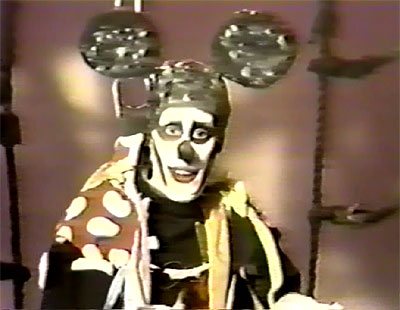 Copyright Disney Enterprises, Inc. All rights reserved
Copyright Disney Enterprises, Inc. All rights reserved
Anywho … there’s actually a couple of gags in “Captain Eeyore” that directly reference the Tweedle-Dum-Tweedle-Dee-mongoloids controversy. With the best one being that moment when the crew of Captain Eeyore’s ship stands cowering before the Supreme Leader …
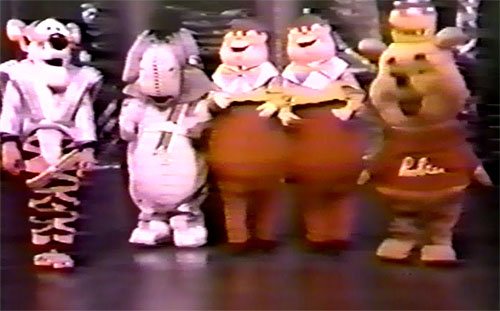 Copyright Disney Enterprises, Inc. All rights reserved
Copyright Disney Enterprises, Inc. All rights reserved
Tweedle Dum now turns to Tweedle Dee and asks:
Tweedle Dum: Who’s that?
Tweedle Dee: The Supreme Leader.
Tweedle Dum: What? Diana Ross?
Tweedle Dee: (exasperated sigh, then …) You really are a mongoloid.
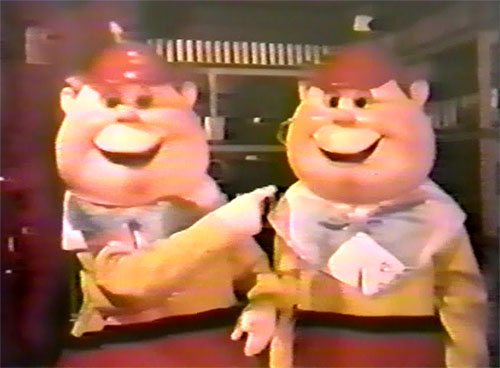 Copyright Disney Enterprises, Inc. All rights reserved
Copyright Disney Enterprises, Inc. All rights reserved
Not to be outdone, Walt Disney World’s Character Department shot their own movie which then made fun of Dick Nunis’ pronouncement. But what WDW’s Zoo Crew did was a parody of / tribute to Madonna‘s “Material Girl” music video. Only in the “Disney Girl” version of this song, Cast Member Sandy Fox played a very Madonna-like version of Alice. And to then add to the fun, Fox was backed up by a chorus of not two but six Tweedles.
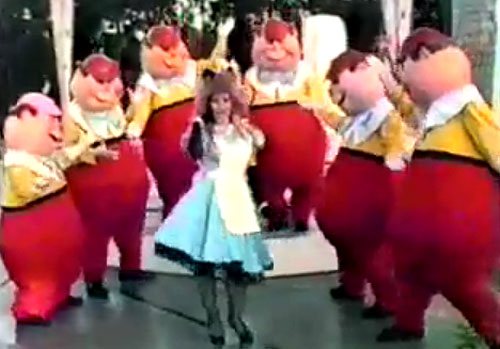 Sandy Fox and her boys from Wonderland. Copyright Disney Enterprises, Inc. All rights reserved
Sandy Fox and her boys from Wonderland. Copyright Disney Enterprises, Inc. All rights reserved
I’m told that – in order to get this many Tweedles for their faux music video (which – obviously – was shot very early in the morning before the Magic Kingdom had officially opened for the day) – the “Disney Girl” production team had to pull out every single Dee & Dum costume that the Wardrobe Department then had in storage. And after this video was completed, it would then be another 5 years before these Tweedle costumes made it out of the Utilidors and back up into the Park.
“And how did Tweedle Dee and Tweedle Dum finally make it back into the theme parks?,” you query. Well, from what I hear, it was another casual remark by Eisner that set the wheels in motion. In late 1991, Michael was supposedly doing a walk-thru of the then-almost-completed “Alice’s Curious Labyrinth” attraction for Euro Disneyland. And Eisner reportedly asked the Imagineer who was giving him this tour why all of the major characters from Disney’s version of “Alice in Wonderland” were represented except the Tweedles.
“But I thought you said that those Alice characters weren’t allowed in the Disney parks anymore because they looked like mongoloids,” this WED vet sputtered.
 Copyright Disney Enterprises, Inc. All rights reserved
Copyright Disney Enterprises, Inc. All rights reserved
“When did I say that?,” Eisner allegedly replied. “I never said that. I think Tweedle Dee & Tweedle Dum are very funny. We should feature those Alice characters more in the Parks.”
And just like that, the Tweedles were out of character jail. In fact, to make sure that Michael knew that WDI was paying attention to what he said, the Imagineers made a point of prominently displaying Tweedle Dum & Tweedle Dee in Downtown Disney‘s then-being-designed superstore, World of Disney.
 The Tweedle Dum & Tweedle Dee store display from WDW’s World of Disney which recently went up for auction at this year’s D23 EXPO. Copyright Disney Enterprises, Inc. All rights reserved
The Tweedle Dum & Tweedle Dee store display from WDW’s World of Disney which recently went up for auction at this year’s D23 EXPO. Copyright Disney Enterprises, Inc. All rights reserved
Anyhow … That’s the story of how a casual remark by Michael Eisner reportedly got Tweedle Dum & Dee bounced out of the Disney theme parks. Only to then have a second off-the-cuff remark by Disney’s then-CEO supposedly get the Brothers suddenly reinstated. That’s the sort of narrative that only Lewis Carroll could of have dreamed up. But this happened in real life.
That’s it for this week’s Why For column. If you have a Disney-related question that you’d like to have answered here on JHM, please send those queries along to whyfor@jimhillmedia.com.
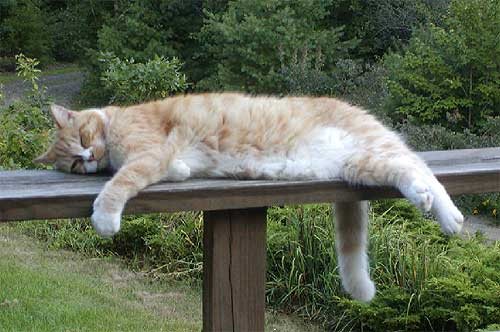 Photo by Nancy Stadler
Photo by Nancy Stadler
Also, could you please do Nancy a favor and go vote for the very Un-Cheshire-like cat depicted above? Thanks.
Your thoughts?
History
The Evolution and History of Mickey’s ToonTown

Disneyland in Anaheim, California, holds a special place in the hearts of Disney fans worldwide, I mean heck, it’s where the magic began after all. Over the years it’s become a place that people visit in search of memorable experiences. One fan favorite area of the park is Mickey’s Toontown, a unique land that lets guests step right into the colorful, “Toony” world of Disney animation. With the recent reimagining of the land and the introduction of Micky and Minnies Runaway Railway, have you ever wondered how this land came to be?
There is a fascinating backstory of how Mickey’s Toontown came into existence. It’s a tale of strategic vision, the influence of Disney executives, and a commitment to meeting the needs of Disney’s valued guests.
The Beginning: Mickey’s Birthdayland
The story of Mickey’s Toontown starts with Mickey’s Birthdayland at Walt Disney World’s Magic Kingdom. Opened in 1988 to celebrate Mickey Mouse’s 60th birthday, this temporary attraction was met with such overwhelming popularity that it inspired Disney executives to think bigger. The idea was to create a permanent, immersive land where guests could step into the animated world of Mickey Mouse and his friends.
In the early ’90s, Disneyland was in need of a refresh. Michael Eisner, the visionary leader of The Walt Disney Company at the time, had an audacious idea: create a brand-new land in Disneyland that would celebrate Disney characters in a whole new way. This was the birth of Mickey’s Toontown.
Initially, Disney’s creative minds toyed with various concepts, including the idea of crafting a 100-Acre Woods or a land inspired by the Muppets. However, the turning point came when they considered the success of “Who Framed Roger Rabbit.” This film’s popularity and the desire to capitalize on contemporary trends set the stage for Toontown’s creation.
From Concept to Reality: The Birth of Toontown
In 1993, Mickey’s Toontown opened its gates at Disneyland, marking the first time in Disney Park history where guests could experience a fully realized, three-dimensional world of animation. This new land was not just a collection of attractions but a living, breathing community where Disney characters “lived,” worked, and played.
Building Challenges: Innovative Solutions
The design of Mickey’s Toontown broke new ground in theme park aesthetics. Imagineers were tasked with bringing the two-dimensional world of cartoons into a three-dimensional space. This led to the creation of over 2000 custom-built props and structures that embodied the ‘squash and stretch’ principle of animation, giving Toontown its distinctiveness.
And then there was also the challenge of hiding the Team Disney Anaheim building, which bore a striking resemblance to a giant hotdog. The Imagineers had to think creatively, using balloon tests and imaginative landscaping to seamlessly integrate Toontown into the larger park.

Key Attractions: Bringing Animation to Life
Mickey’s Toontown featured several groundbreaking attractions. “Roger Rabbit’s Car Toon Spin,” inspired by the movie “Who Framed Roger Rabbit,” became a staple of Toontown, offering an innovative ride experience. Gadget’s Go-Coaster, though initially conceived as a Rescue Rangers-themed ride, became a hit with younger visitors, proving that innovative design could create memorable experiences for all ages.
Another crown jewel of Toontown is Mickey’s House, a walkthrough attraction that allowed guests to explore the home of Mickey Mouse himself. This attraction was more than just a house; it was a carefully crafted piece of Disney lore. The house was designed in the American Craftsman style, reflecting the era when Mickey would have theoretically purchased his first home in Hollywood. The attention to detail was meticulous, with over 2000 hand-crafted, custom-built props, ensuring that every corner of the house was brimming with character and charm. Interestingly, the design of Mickey’s House was inspired by a real home in Wichita Falls, making it a unique blend of real-world inspiration and Disney magic.
Mickey’s House also showcased Disney’s commitment to creating interactive and engaging experiences. Guests could make themselves at home, sitting in Mickey’s chair, listening to the radio, and exploring the many mementos and references to Mickey’s animated adventures throughout the years. This approach to attraction design – where storytelling and interactivity merged seamlessly – was a defining characteristic of ToonTown’s success.

Executive Decisions: Shaping ToonTown’s Unique Attractions
The development of Mickey’s Toontown wasn’t just about creative imagination; it was significantly influenced by strategic decisions from Disney executives. One notable input came from Jeffrey Katzenberg, who suggested incorporating a Rescue Rangers-themed ride. This idea was a reflection of the broader Disney strategy to integrate popular contemporary characters and themes into the park, ensuring that the attractions remained relevant and engaging for visitors.
In addition to Katzenberg’s influence, Frank Wells, the then-President of The Walt Disney Company, played a key role in the strategic launch of Toontown’s attractions. His decision to delay the opening of “Roger Rabbit’s Car Toon Spin” until a year after Toontown’s debut was a calculated move. It was designed to maintain public interest in the park by offering new experiences over time, thereby giving guests more reasons to return to Disneyland.
These executive decisions highlight the careful planning and foresight that went into making Toontown a dynamic and continuously appealing part of Disneyland. By integrating current trends and strategically planning the rollout of attractions, Disney executives ensured that Toontown would not only capture the hearts of visitors upon its opening but would continue to draw them back for new experiences in the years to follow.
Global Influence: Toontown’s Worldwide Appeal
The concept of Mickey’s Toontown resonated so strongly that it was replicated at Tokyo Disneyland and influenced elements in Disneyland Paris and Hong Kong Disneyland. Each park’s version of Toontown maintained the core essence of the original while adapting to its cultural and logistical environment.
Evolution and Reimagining: Toontown Today
As we approach the present day, Mickey’s Toontown has recently undergone a significant reimagining to welcome “Mickey & Minnie’s Runaway Railway” in 2023. This refurbishment aimed to enhance the land’s interactivity and appeal to a new generation of Disney fans, all while retaining the charm that has made ToonTown a beloved destination for nearly three decades.

Dive Deeper into ToonTown’s Story
Want to know more about Mickey’s Toontown and hear some fascinating behind-the-scenes stories, then check out the latest episode of Disney Unpacked on Patreon @JimHillMedia. In this episode, the main Imagineer who worked on the Toontown project shares lots of interesting stories and details that you can’t find anywhere else. It’s full of great information and fun facts, so be sure to give it a listen!
History
Unpacking the History of the Pixar Place Hotel

Pixar Place Hotel, the newly unveiled 15-story tower at the Disneyland Resort, has been making waves in the Disney community. With its unique Pixar-themed design, it promises to be a favorite among visitors.
However, before we delve into this exciting addition to the Disneyland Resort, let’s take a look at the fascinating history of this remarkable hotel.
The Emergence of the Disneyland Hotel
To truly appreciate the story of the Pixar Place Hotel, we must turn back the clock to the early days of Disneyland. While Walt Disney had the visionary ideas and funding to create the iconic theme park, he faced a challenge when it came to providing accommodations for the park’s visitors. This is where his friend Jack Wrather enters the picture.
Jack Wrather, a fellow pioneer in the television industry, stepped in to assist Walt Disney in realizing his dream. Thanks to the success of the “Lassie” TV show produced by Wrather’s company, he had the financial means to build a hotel right across from Disneyland.
The result was the Disneyland Hotel, which opened its doors in October 1955. Interestingly, the early incarnation of this hotel had more of a motel feel than a hotel, with two-story buildings reminiscent of the roadside motels popular during the 1950s. The initial Disneyland Hotel consisted of modest structures that catered to visitors looking for affordable lodging close to the park. While the rooms were basic, it marked the beginning of something extraordinary.
The Evolution: From Emerald of Anaheim to Paradise Pier
As Disneyland’s popularity continued to soar, so did the demand for expansion and improved accommodations. In 1962, the addition of an 11-story tower transformed the Disneyland Hotel, marking a significant transition from a motel to a full-fledged hotel.
The addition of the 11-story tower elevated the Disneyland Hotel into a more prominent presence on the Anaheim skyline. At the time, it was the tallest structure in all of Orange County. The hotel’s prime location across from Disneyland made it an ideal choice for visitors. With the introduction of the monorail linking the park and the hotel, accessibility became even more convenient. Unique features like the Japanese-themed reflecting pools added to the hotel’s charm, reflecting a cultural influence that extended beyond Disney’s borders.
Japanese Tourism and Its Impact
During the 1960s and 1970s, Disneyland was attracting visitors from all corners of the world, including Japan. A significant number of Japanese tourists flocked to Anaheim to experience Walt Disney’s creation. To cater to this growing market, it wasn’t just the Disneyland Hotel that aimed to capture the attention of Japanese tourists. The Japanese Village in Buena Park, inspired by a similar attraction in Nara, Japan, was another significant spot.
These attractions sought to provide a taste of Japanese culture and hospitality, showcasing elements like tea ceremonies and beautiful ponds with rare carp and black swans. However, the Japanese Village closed its doors in 1975, likely due to the highly competitive nature of the Southern California tourist market.
The Emergence of the Emerald of Anaheim
With the surge in Japanese tourism, an opportunity arose—the construction of the Emerald of Anaheim, later known as the Disneyland Pacific Hotel. In May 1984, this 15-story hotel opened its doors.
What made the Emerald unique was its ownership. It was built not by The Walt Disney Company or the Oriental Land Company (which operated Tokyo Disneyland) but by the Tokyu Group. This group of Japanese businessmen already had a pair of hotels in Hawaii and saw potential in Anaheim’s proximity to Disneyland. Thus, they decided to embark on this new venture, specifically designed to cater to Japanese tourists looking to experience Southern California.
Financial Challenges and a Changing Landscape
The late 1980s brought about two significant financial crises in Japan—the crash of the NIKKEI stock market and the collapse of the Japanese real estate market. These crises had far-reaching effects, causing Japanese tourists to postpone or cancel their trips to the United States. As a result, reservations at the Emerald of Anaheim dwindled.
To adapt to these challenging times, the Tokyu Group merged the Emerald brand with its Pacific hotel chain, attempting to weather the storm. However, the financial turmoil took its toll on the Emerald, and changes were imminent.
The Transition to the Disneyland Pacific Hotel
In 1995, The Walt Disney Company took a significant step by purchasing the hotel formerly known as the Emerald of Anaheim for $35 million. This acquisition marked a change in the hotel’s fortunes. With Disney now in control, the hotel underwent a name change, becoming the Disneyland Pacific Hotel.
Transformation to Paradise Pier
The next phase of transformation occurred when Disney decided to rebrand the hotel as Paradise Pier Hotel. This decision aligned with Disney’s broader vision for the Disneyland Resort.
While the structural changes were limited, the hotel underwent a significant cosmetic makeover. Its exterior was painted to complement the color scheme of Paradise Pier, and wave-shaped crenellations adorned the rooftop, creating an illusion of seaside charm. This transformation was Disney’s attempt to seamlessly integrate the hotel into the Paradise Pier theme of Disney’s California Adventure Park.
Looking Beyond Paradise Pier: The Shift to Pixar Place
In 2018, Disneyland Resort rebranded Paradise Pier as Pixar Pier, a thematic area dedicated to celebrating the beloved characters and stories from Pixar Animation Studios. As a part of this transition, it became evident that the hotel formally known as the Disneyland Pacific Hotel could no longer maintain its Paradise Pier theme.
With Pixar Pier in full swing and two successful Pixar-themed hotels (Toy Story Hotels in Shanghai Disneyland and Tokyo Disneyland), Disney decided to embark on a new venture—a hotel that would celebrate the vast world of Pixar. The result is Pixar Place Hotel, a 15-story tower that embraces the characters and stories from multiple Pixar movies and shorts. This fully Pixar-themed hotel is a first of its kind in the United States.
The Future of Pixar Place and Disneyland Resort
As we look ahead to the future, the Disneyland Resort continues to evolve. The recent news of a proposed $1.9 billion expansion as part of the Disneyland Forward project indicates that the area surrounding Pixar Place is expected to see further changes. Disneyland’s rich history and innovative spirit continue to shape its destiny.
In conclusion, the history of the Pixar Place Hotel is a testament to the ever-changing landscape of Disneyland Resort. From its humble beginnings as the Disneyland Hotel to its transformation into the fully Pixar-themed Pixar Place Hotel, this establishment has undergone several iterations. As Disneyland Resort continues to grow and adapt, we can only imagine what exciting developments lie ahead for this iconic destination.
If you want to hear more stories about the History of the Pixar Place hotel, check our special edition of Disney Unpacked over on YouTube.
Stay tuned for more updates and developments as we continue to explore the fascinating world of Disney, one story at a time.
History
From Birthday Wishes to Toontown Dreams: How Toontown Came to Be

In the latest release of Episode 4 of Disney Unpacked, Len and I return, joined as always by Disney Imagineering legend, Jim Shull. This two-part episode covers all things Mickey’s Birthday Land and how it ultimately led to the inspiration behind Disneyland’s fan-favorite land, “Toontown”. But let’s not get ahead of ourselves here. It all starts in the early days at Disneyland.
Early Challenges in Meeting Mickey
Picture this: it’s the late 1970s and early 1980s, and you’re at Disneyland. You want to meet the one and only Mickey Mouse, but there’s no clear way to make it happen. You rely on Character Guides, those daily printed sheets that point you in Mickey’s general direction. But let’s be honest, it was like finding a needle in a haystack. Sometimes, you got lucky; other times, not so much.

Mickey’s Birthdayland: A Birthday Wish that Came True
Fast forward to the late 1980s. Disney World faced a big challenge. The Disney-MGM Studios Theme Park was under construction, with the company’s marketing machine in full swing, hyping up the opening of Walt Disney World’s third theme park, MGM Studios, in the Spring of 1989. This extensive marketing meant that many people were opting to postpone their family’s next trip to Walt Disney World until the following year. Walt Disney World needed something compelling to motivate guests to visit Florida in 1988, the year before Disney MGM Studios opened.
Enter stage left, Mickey’s Birthdayland. For the first time ever, an entire land was dedicated to a single character – and not just any character, but the mouse who started it all. Meeting Mickey was no longer a game of chance; it was practically guaranteed.

The Birth of Birthdayland: Creative Brilliance Meets Practicality
In this episode, we dissect the birth of Mickey’s Birthdayland, an initiative that went beyond celebrating a birthday. It was a calculated move, driven by guest feedback and a need to address issues dating back to 1971. Imagineers faced the monumental task of designing an experience that honored Mickey while efficiently managing the crowds. This required the perfect blend of creative flair and logistical prowess – a hallmark of Disney’s approach to theme park design.
Evolution: From Birthdayland to Toontown
The success of Mickey’s Birthdayland was a real game-changer, setting the stage for the birth of Toontown – an entire land that elevated character-centric areas to monumental new heights. Toontown wasn’t merely a spot to meet characters; it was an immersive experience that brought Disney animation to life. In the episode, we explore its innovative designs, playful architecture, and how every nook and cranny tells a story.

Impact on Disney Parks and Guests
Mickey’s Birthdayland and Toontown didn’t just reshape the physical landscape of Disney parks; they transformed the very essence of the guest experience. These lands introduced groundbreaking ways for visitors to connect with their beloved characters, making their Disney vacations even more unforgettable.
Beyond Attractions: A Cultural Influence
But the influence of these lands goes beyond mere attractions. Our episode delves into how Mickey’s Birthdayland and Toontown left an indelible mark on Disney’s culture, reflecting the company’s relentless dedication to innovation and guest satisfaction. It’s a journey into how a single idea can grow into a cherished cornerstone of the Disney Park experience.

Unwrapping the Full Story of Mickey’s Birthdayland
Our two-part episode of Disney Unpacked is available for your viewing pleasure on our Patreon page. And for those seeking a quicker Disney fix, we’ve got a condensed version waiting for you on our YouTube channel. Thank you for being a part of our Disney Unpacked community. Stay tuned for more episodes as we continue to “Unpack” the fascinating world of Disney, one story at a time.
-
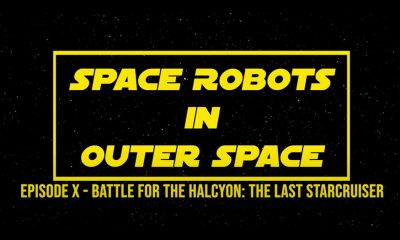
 News & Press Releases12 months ago
News & Press Releases12 months agoStar Wars Spoof: Space Robots in Outer Space Ep X: Battle for the Halcyon: The Last Starcruiser
-

 History11 months ago
History11 months ago31 Long-Gone Rides, Shows & Attractions at Disney-MGM (Hollywood Studios)
-

 News & Press Releases8 months ago
News & Press Releases8 months agoDisney Will Bring D23: The Ultimate Disney Fan Event to Anaheim, California in August 2024
-

 History3 months ago
History3 months agoFrom Birthday Wishes to Toontown Dreams: How Toontown Came to Be
-

 Theme Parks & Themed Entertainment11 months ago
Theme Parks & Themed Entertainment11 months agoFrom Aladdin to Indy – How Did We Get an Indiana Jones Stage Show at Disneyland?
-

 Theme Parks & Themed Entertainment12 months ago
Theme Parks & Themed Entertainment12 months agoHow Did We Get “Aladdin’s Oasis” at Disneyland?
-

 Theme Parks & Themed Entertainment10 months ago
Theme Parks & Themed Entertainment10 months agoWhen WDW Had a Racetrack – The Creation of the Walt Disney World Speedway
-

 Film & Movies10 months ago
Film & Movies10 months ago“Indiana Jones and the Search for Indiana Jones”

